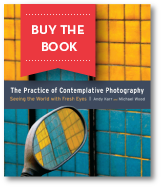Texture
You can feel visual texture everywhere: from the roughness of a concrete wall, to the smoothness of a car’s trim, to the bumpiness of a maple tree’s bark, to the softness of a child’s skin. Seeing texture has an almost tactile quality, which can help you connect deeply with form. As you move through the world, you can feel your way as you look.
Notice how the quality of light affects the perception of texture. Rough surfaces will look one way on an overcast day; another on a bright, sunny day; and another in twilight. When an object is lit strongly from the side, the sharply contrasting brightness and shadow will give it more depth and dimension. When the light is indirect, the texture will be apparent but less pronounced. At twilight the texture will be muted.
As you do this assignment, it’s important to look not for textured things but for the visual experience of texture itself. Whether it is rough or smooth—creases in soft leather or the sheen of satin—it should become tangible visually. Feel the surface with your eye, mind, and gut. If you try to shoot textured things, you might think, “Bark is rough and rocks are jagged. I should go looking for some bark and rocks to shoot.” When you find bark and rocks, you could shoot them without actually experiencing their textures. You see them, and they confirm your preconceptions: “Yup, those things are pretty rough.” Then you take some pictures without really seeing anything. That would defeat the purpose of the exercise.

